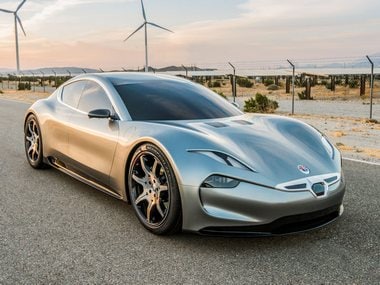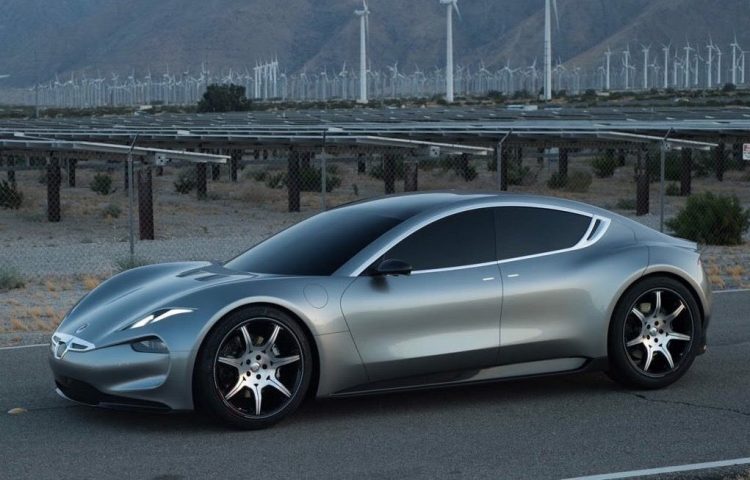

Fisker hasn’t released capacity specifics but says the Ocean Sport will have a 250-mile range. All Oceans will have batteries supplied by CATL, although the Sport will use lower-cost lithium-iron phosphate batteries like what Tesla uses for its standard range models. Using a front motor allows the Ocean to maximize regenerative braking for extra range and improves poor weather traction. The base Ocean Sport has a single 275-horsepower unit driving the front wheels. Sam Abuelsamid The Ocean’s Electric Powertrain The Fisker Ocean will be offered in both single- and dual-motor forms with varying range and horsepower. A fixed hood allowed Fisker to avoid using seals, latches and liners, which keep the base price down. Service personnel can open it, but with the front motor and power electronics there, there isn’t much room for storage. There is no frunk (front trunk) and what would traditionally be called the hood is fixed as on the BMW iX. One place owners won’t find space is under the front of the Ocean. Six-foot-tall CEO Henrik Fisker demonstrated the ample rear seat leg and headroom. The center console of the Ocean floats leaving room under both it and the seats for rear seat passengers to extend their legs and feet. Temperature control sits at the base of the screen when it’s in portrait mode and stays even when the screen rotates. Unlike Tesla and Ford, Fisker believes that some controls, especially its climate system, are better with physical buttons that can be felt without looking at them. The Ocean offers other west coast-themed modes, including a large 17.1-inch vertical central touchscreen that rotates 90 degrees into “Hollywood mode” for watching videos while charging. With everything open, the feel is not unlike a topless Jeep Wrangler.
Fisker emotion windows#
The Ocean offers a “California mode,” where all four door windows, the rear quarter windows and tailgate window lower while the roof slides back Fisker claims the sunroof has the largest aperture in the industry. Unlike those rivals, the Fisker keeps a long-roof, wagon-like profile that aids rear stowage and enables the sliding sunroof. Measuring 188 inches, the Ocean is roughly the same size as the Tesla Model Y and Ford Mustang Mach-E, but its wheelbase stretches is a bit longer at 115-inches. The interior of the Ocean has a vertical screen that can swivel into a landscape position called “Hollywood mode” that lets passengers consume media while charging. Magna set aside production capacity for up to 50,000 Oceans per year from its Austrian plant with about half allocated to North America and the rest to Europe. Starting from there, Fisker and Magna developed what has been dubbed the Fisker FM29 platform, which is now about 90% proprietary to Fisker. Magna had already developed an EV reference platform to demonstrate the various components it could provide as well as its ability to help engineer and produce the vehicles. Volume production is scheduled to start November 2022. That facility in Graz, Austria is already building pre-production prototypes of the Ocean and is expected to be producing two Oceans per day by March.

The company’s Magna Steyr subsidiary in Austria has been assembling complete vehicles for automakers including Mercedes-Benz, Stellantis, BMW, Jaguar Land Rover and others for decades. Instead, Fisker formed a partnership with Magna International, the Canadian automotive supplier that has almost every modern vehicle part in its portfolio. Fisker tried to make a deal with VW to use MEB in production, but that never came to fruition. The original 2020 Ocean concept was built around Volkswagen’s MEB platform, the same architecture used for the VW ID.4 and other EVs coming from the German automaker. DAVID MC – AFP via Getty Images Bringing the Ocean to Market Henrik Fisker’s Emotion concept debuted at the 2018 Consumer Electronic Show and was targeted the high end of the EV market. Turning it into a real product is something else entirely. As Henrik Fisker and every entrepreneur in the last 130 years that has ever tried to launch a car company knows, the design concept is the easy part. Unlike the high-dollar Emotion, the five-passenger Ocean is targeted at the mass market with an attainable price point. In 2020, Fisker returned to CES with the Ocean.

made a splash with at the 2018 Consumer Electronics Show with the Emotion electric sedan-an overly ambitious effort that may or may not materialize. was born in 2016, several years after the collapse of Fisker Automotive and the plug-in hybrid Karma grand touring sedan, a project that lives on as the Chinese-owned Karma Automotive.


 0 kommentar(er)
0 kommentar(er)
